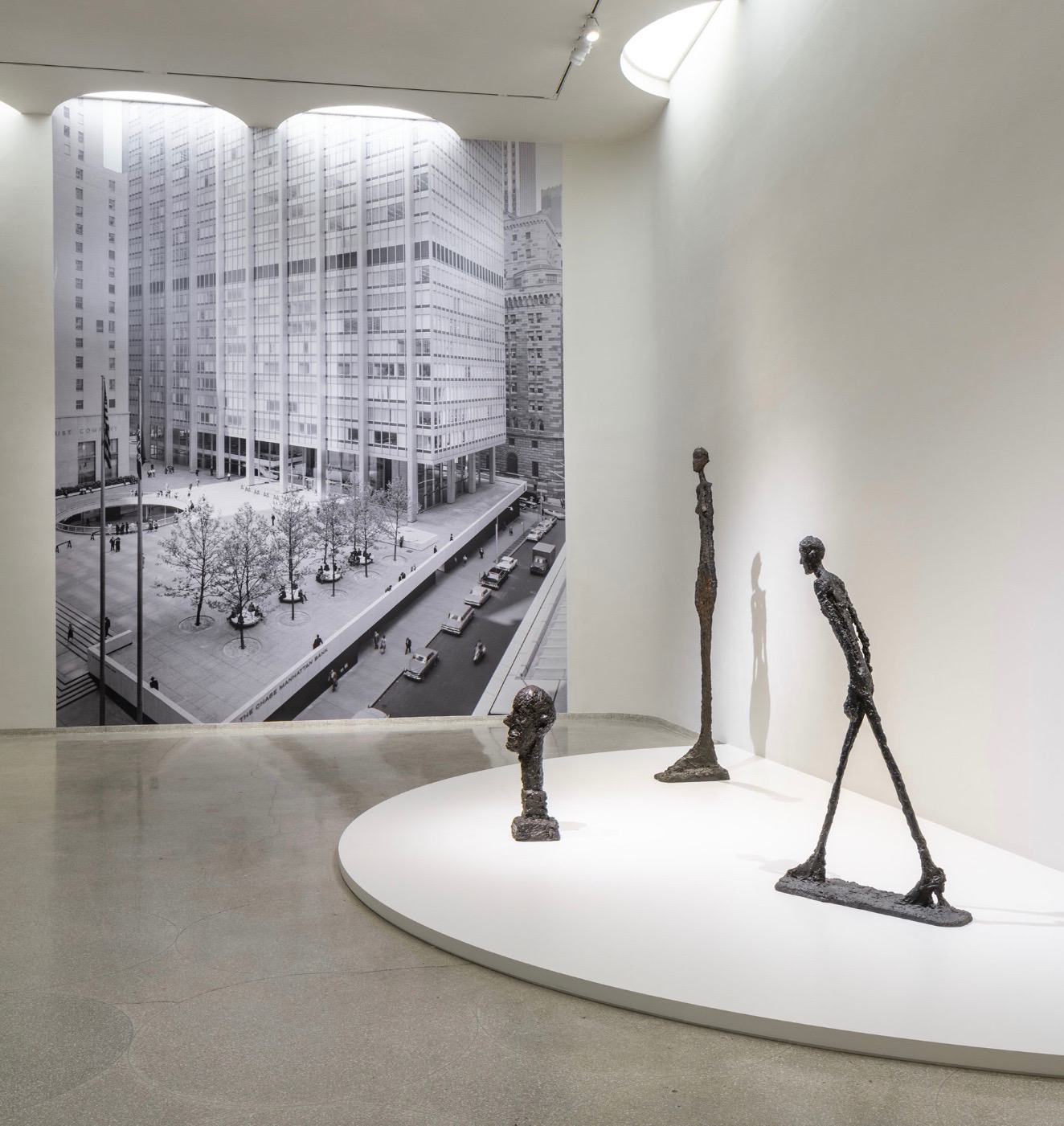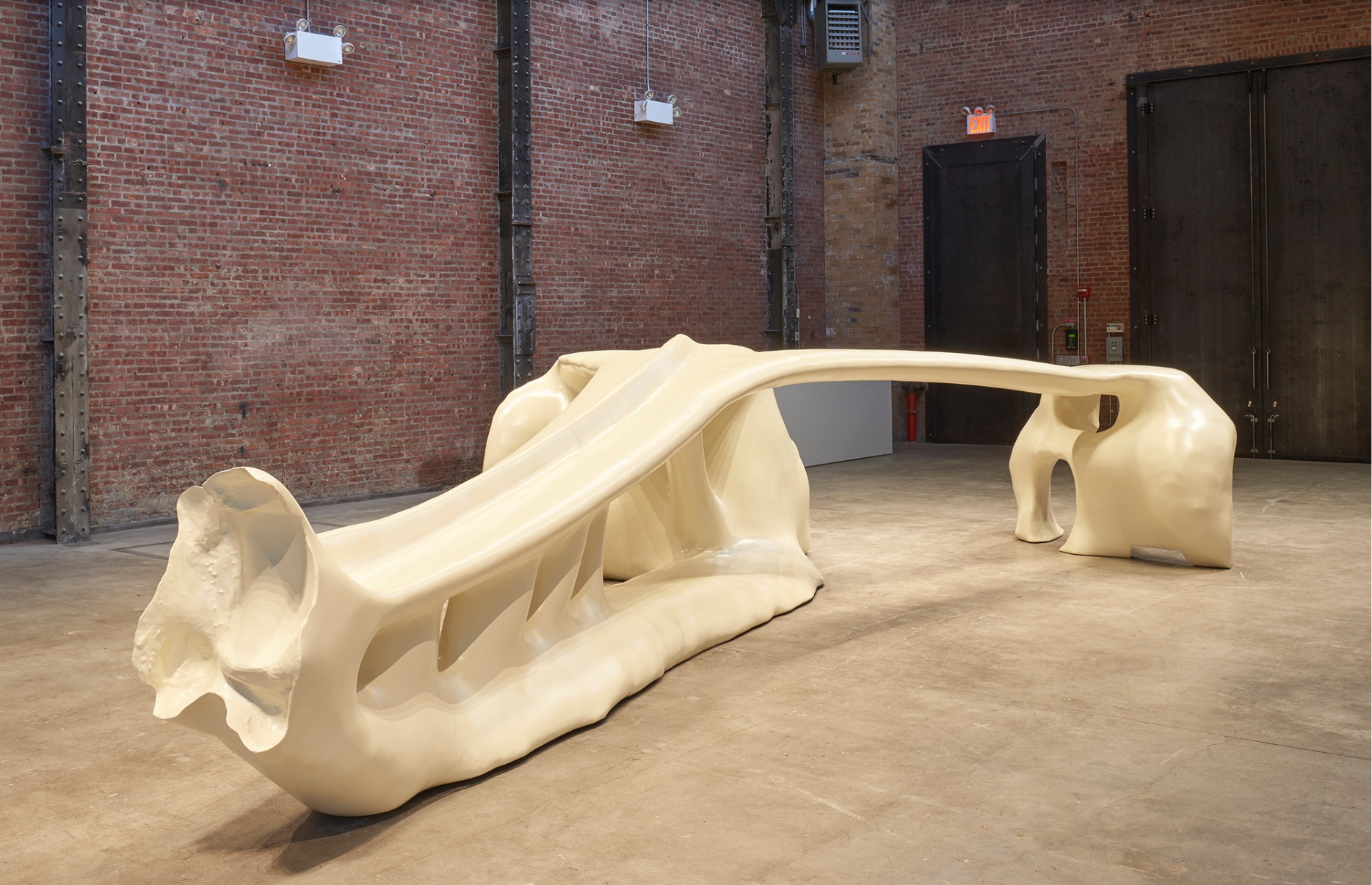The Palace at 4 a.m. Giacometti Guggenheim Museum Through September 11, 2018

By Bradley Rubenstein
“I am a camera with its shutter open, quite passive, recording, not thinking. Recording the man shaving at the window opposite and the woman in the kimono washing her hair. Some day, all this will have to be developed, carefully printed, fixed.”
Christopher Isherwood, Goodbye to Berlin
“A deception that elevates us is dearer than a host of low truths.”
Aleksander Pushkin
Like Pablo Picasso, Francis Bacon, and Willem de Kooning, Alberto Giacometti (1901-1966) has become something of an icon of mid-20th century existential figurative painting. At once going against the prevailing trend toward Modernist abstraction, Giacometti sought to continue the traditional notions of classical figurative painting during a time when those ideas seemed growingly irrelevant in the century that saw two World Wars, AIDS and a cure for polio, the invention of mass television and radio, X-rays and LSD, Pop Tarts and the hydrogen bomb, Freud and death camps.
Giacometti was the son of Giovanni Giacometti, a minor post-Impressionist painter, and the older brother of Diego, a sculptor of animals, who would later become responsible for the casting and patinas of Giacometti’s sculptures. From the beginning of his career Giacometti seemed uniquely destined to record the transitions, vagaries, and intellectual ideas that surrounded him after his move to Paris in 1922. Like his father, Giacometti began as a painter, particularly influenced by both Cezanne’s revolutionary notions of fracturing the picture plane, as well as his nervous, stenographic brushwork. Giacometti’s career has been traditionally divided into two separate “periods”, the first, a decade long affair with André Breton’s
Surrealism, began a fertile period of sculptural investigation which allowed Giacometti to shed some of the more overt influences of Cezanne, Cubism, and probably most significant, with the work of his father. Sculptures such as Woman with Her Throat Cut, (1932), Hands Holding the Void, (1934) and The Palace at 4 a.m., (1932), reflect Giacometti’s assimilation of Breton’s notions of the unconscious, as well as delving into some of the more “dissident Surrealists” who were influenced by Michel Leiris and George Bataille, Throughout the 1930s Giacometti would make some of the most iconic of his “object-sculptures”, which, like the paintings of Juan Miro, merged the figure and abstract elements into a new vocabulary. Even at their most abstract, as in Cube (1934), these works are imbued with figurative elements. The hand-smoothed surface of the object belies its aspirations as a Platonic Solid, recording the countless, obsessive hours spent ameliorating it into its final form. The philosopher and art historian Georges Didi-Huberman noted that Cube marks the transition between Giacometti’s Surrealist and Realist periods, including his interest in portraying dimensionality, the relation of the figure to geometry, and what Didi-Huberman termed Giacometti’s “abstract anthropomorphism”. Cube is both a foreshadowing of Giacometti’s changing style of portraiture, as well as a memorial to a type of “handmade” sculpture that would almost cease to exist 20 years later.
Giacometti’s interest in literature is somewhat undocumented; James Lord noted that the only books he ever saw in the studio that Giacometti shared with his wife Annette Arm were spy novels which he read during insomnia plagued nights. However, a form of narrative structured some of his strongest works. The nightmare dollhouse of The Palace at 4a.m. with its moveable elements, evoke the haunted rooms of the fractured collective human condition in the aftermath of the war. No More Play, (1931-2), a marble game board which resembles a cemetery, is “played” with wood and bronze “pieces”. The marble is cratered with indentations and holes, a smooth center panel, containing a tiny grave divided the board. With no discernable rules of engagement, No More Play becomes a sadistic twist on children’s games as well as a metaphor for a society that was slowly learning of the horrors of the front.
It would be Giacometti’s second act that would solidify his position as a major figure of 20th century painting, when he abandoned the more literary pretensions of Breton and returned to portraiture after the Second World War. It began, he told Breton shortly before his exit from the Surrealist camp, with a desire to just “paint a nose on a face”. Giacometti’s in returning to the figure was of course more complex. He said, “In the street people astound and interest me more than any sculpture or painting. Every second the people stream together and go apart, then they approach each other to get closer to one another They increasingly form and reform living compositions of unbelievable complexity.” Like Alain Robbe-Grillet and Christopher Isherwood, Giacometti’s work privileged the idea of the modern artist as recording device.
Figure Between Two Houses (1950), like Cube, is a transitional work, incorporating the geometry of the structure, with a signature Giacometti “stick figure.” The figure crosses between two box-like houses, which are connected with an empty road or bridge. The composition of the sculpture, coupled with its size and scale, resembles a mid-century television console, with a figure moving across the screen. Giacometti, like Bacon, encased many of his figures in a cage structure. Bacon derived his from well know photographs of the Nuremberg Trials, and Edward Muybridge’s grids. Giacometti, unlike Picasso, who delighted in watching comedies and catch wrestling on television, eschewed having the device in his studio. One wonders if Between Two Houses was merely a one-off formal device, or just the technology of contemporary culture seeping into his work. While he didn’t watch television, he did love going to the movies, and his last girlfriend, Caroline styled herself after the “stars” of the 60s.
While the action of Figure Between Two Houses implies movement and life, the head trapped in a cage in The Nose speaks to Giacometti grappling with understanding death. Revisiting the figure-in-an-environment format of his Surrealist work Suspended Ball (1930-31) and Palace, Giacometti inserts a head, cragged like a lunar surface, the mouth a rictus, man transformed by death. Having witnessed firsthand a travelling companion die in 1945, Giacometti worte in 1946 of the transformation of the body in death. “His nose lengthening, his cheeks grow hollow…” This back and forth between depicting the living under attack by entropy and death would consume the next two decades.
The apocrypha cannot, with any degree of certainty be separated by mere fact. Chiseling away at both paint and plaster, his circle of subjects narrowed to mostly women he knew personally,
Annette, his mother, Caroline, and a few men he was close to, Diego, Bust of Diego, (1964) or Ely Lotar, Head of a Man (Lotar 1), (1964), or the occasional writer, James Lord, Gene Genet, who often came to record him recording them. His anxiety-filled process created a demanding job for those sitters. Giacometti demanded stillness, as well as direct eye-contact while he worked, and the deer-in-the-headlights expression on his subject’s faces was the result of the endless hours of posing as much as any existential dread.
The Guggenheim ends the exhibition with Dog, (1957), one of the most moving depictions of an animal in art; Picasso’s painting of predatory cats of the period being the inverse. For an artist who had so focused his eye on the human subject, it is something of a paradox that Dog might be his most humanist sculpture, describing in its bent and hungry form the despair that Louis-Ferdinand Céline would portray in Journey to the End of the Night. “That street was like a dismal gash, endless, with us at the bottom of it, filling it from side to side, advancing from sorrow to sorrow, toward an end that is never in sight, the end of all the streets in the world.”




